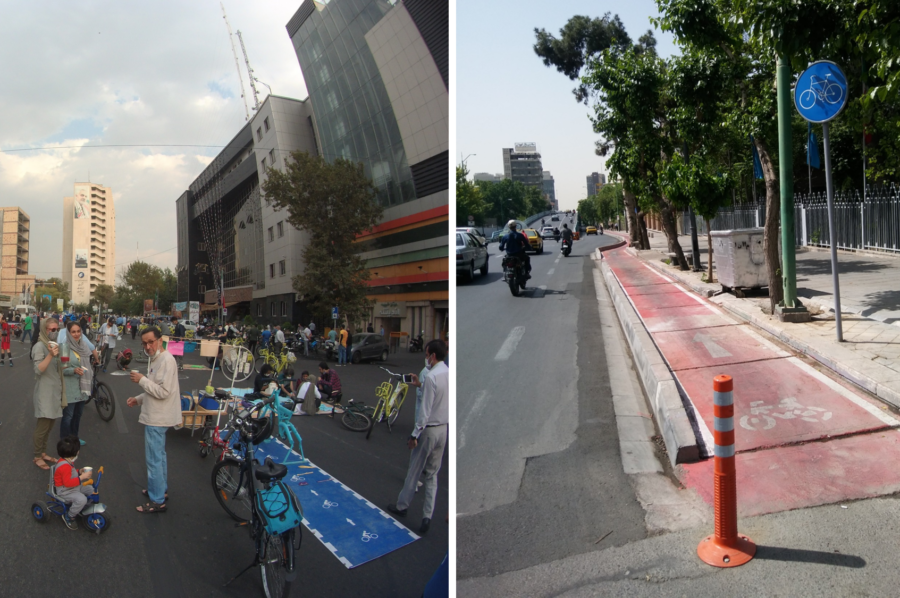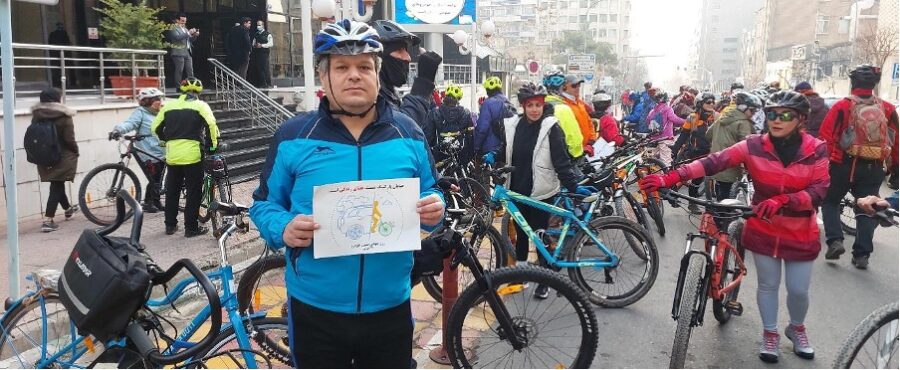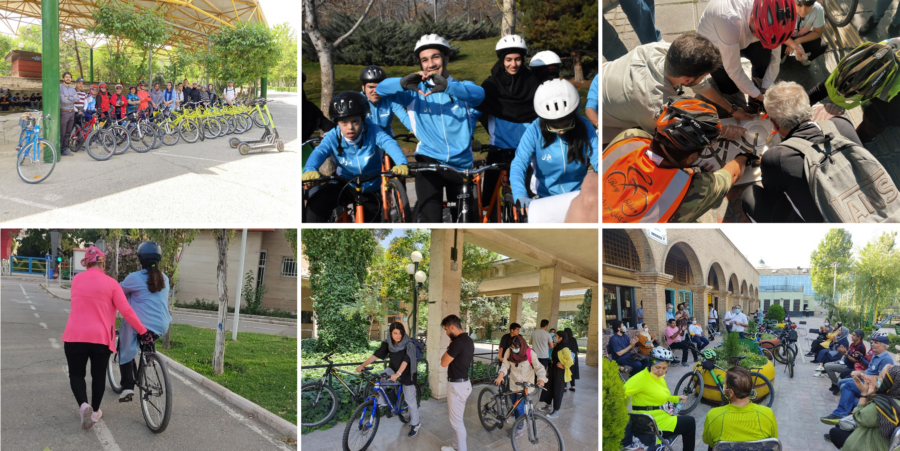Mohammad Nazarpoor is a PHD candidate in Urban Planning at Tarbiat Modares University in Tehran, and an activist promoting cycling, most recently appointed as Bicycle Mayor of the Iranian Capital. In this essay he emphasizes the importance of the human infrastructure of cycling in cities dominated by cars.
–
The bicycle is emerging as a simple tool that can play an effective role in addressing complex urban challenges and transforming various aspects of our urban life. It can become an important mode for short trips, while connecting with public transportation for long trips. It alleviates many environmental problems, promotes individual and social community health, improves human relationships and social ties, builds socio-cultural identities with others and places, and plays a leading role in creating human-centered cities.
Despite these obvious benefits, planning for cycling in car-oriented environments is politically contentious and presents several contextual challenges. Tehran for example, as a car-dominated city, has experienced ups and downs in urban cycling development over the past two decades and faces many challenges in staying on track with a long-term planning process due to a variety of factors.
In 2017, a new round of infrastructure development for this mode of transport began with the preparation of Bicycle Masterplan Tehran (BMT), a five-year plan for cycling, which brought progress in transforming our urban mobility system. According to the master plan, the required approaches and measures are defined in three sections: Hardware, Software and Orgware. All three aspects have been defined as closely linked and must work hand in hand.
The hardware section includes the construction of safe bike lanes, safe intersections, bicycle parking, etc. The software section encompasses training, education and communication, awareness raising, public events, breaking down mental barriers, etc. The orgware section is related to budgeting, traffic regulation, involvement of relevant stakeholders, interorganisational coordination, etc. In the implementation period, the hardware section made some progress, however the software section is falling behind. This issue is related to the cultural and socio-political processes of developing cycling in our context.
Tehran is a car-dominated city, which has been built up through successive car-planning policies and long-term investment in car use over decades, along with a strong car culture that shaped people’s lifestyles, reinforced car centric city-planning. In this context, it is important to focus on the emerging significant concept of “human infrastructure”. Short-term, project-driven approaches to building hard infrastructure, and insufficient attention to human infrastructure and community engagement were some of the most important challenges in cycling development in Tehran.
This valuable framework was first used by Adonia Lugo during ethnographic research on the Open Street Event in Los Angeles and further developed by BYCS, with particular attention to the emotional, social and educational aspects of cycling which looks beyond the logic of “build it and they will come” and focuses on soft measures and community-led initiatives to reinforce cycling cultures.
To facilitate and encourage cycling in a car-dominated city with strong car culture, human infrastructure has a critical role to play. It refers to the network of services, policies, and cultural support systems that are essential to the successful development of urban cycling. Initiatives like education campaigns, events, empowering vulnerable groups, improving accessibility for all, and community outreach programs are essential components that promote the benefits of cycling and transform public perceptions. By actively engaging communities and encouraging participation, the human infrastructure supports a shift toward embracing cycling as a reliable mode of transportation.

Human infrastructure VS Hard infrastructure in Tehran. Photo: Mohammad Nazarpoor
Raising awareness on the human infrastructure of cycling
Cycling activists advocate for the benefits of cycling, and play a crucial role in raising awareness about the importance of human infrastructure in creating cycling-friendly cities. With their extensive knowledge of cycling in specific contexts, they are well-equipped to identify and tackle the contextual challenges and obstacles that may hinder the development of cycling for all. By actively engaging with policymakers and the general public, activists ensure that cycling is given the attention it deserves and that the necessary policies are in place to support its growth.
Activists also create a platform for public discourse, stimulating conversations that can drive positive change. Their role is particularly vital in environments that have long been dominated by car-centric approaches, where top-down policies and planning have impeded the progress of sustainable active mobility.
In the Iranian context, the academic community in urban disciplines are passive to the real urban challenges and mainly seeks to develop theoretical knowledge. On the other hand, urban planning professionals and urban politicians also support top-down approaches and car-oriented planning. Meanwhile, the role of urban activists in Tehran society is very prominent. The bottom-up practices and grassroots movements within everyday life have a significant impact on raising awareness and empowering communities through the bicycle. Cycling activists can act as catalysts, connecting citizens with influential actors and catalysing the transformative change needed to build a cycling-centered urban environment.

Cycling activists take a stand against air pollution and car-centered development, protesting in front of a municipal building in Tehran. What is written on the paper: The street is not a parking lot, but a “living space”. Photo: Mohammad Nazarpoor
Understanding the human infrastructure of cycling
Human infrastructure is the main driver of the “cultural shift” in mobilities. The car-centric situation of cities like Tehran is not their inherent characteristic, but it is the result of choices. One of the common misconceptions in Tehran is that traffic congestion is an unchangeable situation and the city is doomed to continue on its current path. We overlook the importance of exploring embodied knowledge of mobility practices when promoting cycling, which is a core tenet of the human infrastructure framework. Greater understanding of human infrastructure can clarify common fallacies, address mental barriers, help dismantle the prevailing car-centric mindset, and be a stimulus to change the overall, current situation of car-dominated environments.
Human infrastructure is dependent on contextual cultural, social, political, environmental, and economic characteristics. Therefore, we can succeed in strengthening it when we can first understand its different dimensions in our cities. Embodied knowledge and lived experiences of people and their mobility practices build the foundation of human infrastructure. Questions such as “How do people experience mobilities in my context? What are the mental barriers to choosing a bicycle? What is the mobile lived experience of women, children, and marginalised groups in my context?”, among others, can highlight different dimensions of human infrastructure that are related to indigenous and embodied knowledge.
Understanding this requires the use of appropriate approaches, interdisciplinary approaches, and methodological toolkits.
By incorporating interpretive, qualitative methodologies, like mobile autoethnography, and user-oriented methods, like the Bicycle User Experience (BUX), we can enhance our understanding of the human infrastructure of cycling. This area of study necessitates collaborative efforts from various disciplines to develop a comprehensive methodological toolkit. This allows us to delve deeper into the embodied knowledge of cyclists and non-cyclists, exploring their experiences, preferences, and challenges. This kind of interdisciplinary approach also facilitates a holistic understanding of the complex dynamics between humans, the built environment, and cycling behaviour. Ultimately, investing in the development of these research methods will lead to the creation of more sustainable, inclusive, and enjoyable cycling environments for individuals of all backgrounds and abilities.
Strengthening the human infrastructure of cycling
By emphasizing the development of hard infrastructure, such as bike lanes, it is not possible to change the dominant car culture. It is true that these “hard” infrastructure strategies have a proven impact on modal shifts toward cycling, but solely relying on them has several limitations. Tehran has paid attention to the quantitative development of hard infrastructure in recent years, but not to human infrastructure. The use of hard infrastructure is influenced by socio-cultural norms, perceptual diversity, gender issues, different lifestyles, and different political-social processes in every context.
Strengthening the human infrastructure of cycling is about addressing barriers, increasing community engagement, cycling stimulation, temporary urban activations, and improving access to bicycles to change individual and collective mobility habits that can be defined under the umbrella of “soft measures”. Both hard and soft infrastructures must be developed in a balanced and simultaneous manner, and this requires that simple notions and false causal relationships be rejected. “Let’s build bike lanes so there are more cyclists” or “Let’s change the culture first and then build bike lanes”. Our car environments can be transformed in a long-term and continuous process if we develop both hard and soft infrastructure simultaneously.

Examples of soft measures used to strengthen the human infrastructure of cycling in Tehran. Photo: Mohammad Nazarpoor
Cities have the potential to enhance the cycling ecosystem and promote sustainability and livability by raising awareness, improving understanding, and reinforcing human infrastructure. This collaborative effort between academics and activists is crucial. Academics can conduct thorough research to better understand the human infrastructure, while activists can increase awareness and actively contribute to its development. Together, they can transform car-centric environments by prioritising cycling, thus fulfilling the important goal of effecting significant change in our cities.

